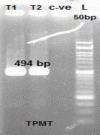Thiopurine S-methyltransferase and Pemphigus Vulgaris: A Phenotype-Genotype Study
- PMID: 32944042
- PMCID: PMC7477690
- DOI: 10.30699/ijp.2020.121365.2320
Thiopurine S-methyltransferase and Pemphigus Vulgaris: A Phenotype-Genotype Study
Abstract
Background & objective: Thiopurine drugs are considered as a treatment modality in various autoimmune disorders including pemphigus vulgaris (PV). These drugs are metabolized by an enzyme "Thiopurine S-methyl transferase" (TPMT). Various variants of this enzyme may have decreased activity leading to serious drug side effects. To investigate the phenotype and genotype of TPMT in PV patients receiving thiopurine drugs.
Methods: A total of 50 patients (29 women and 21 men) with pemphigus vulgaris treating with standard dose of Thiopurine drugs were selected. Sex, age, result of liver function test and complete blood count were recorded. Genotyping of two common non-functional allele (TPMT*2 and TPMT*3C) by Allele-specific and RFLP-PCR was performed. TPMT enzymatic level was determined by an ELISA based method.
Results: Of patients, 36 (72%) were found to have normal TPMT level; and 12, (24%) had higher level of enzyme and 2, 4% had low TPMT enzyme, but none of the patients showed mutant TPMT*2 and TPMT*3C alleles. None of the patients showed hepatotoxicity and bone marrow suppression.
Conclusion: The phenotypic assay based on ELISA method may have false positive and misleading results but genotyping using PCR-RFLP and allele specific PCR is accurate, simple and cost-effective and can be used in patients decided to undergo thiopurine treatment.
Keywords: Allele specific PCR; ELISA test; PCR-RFLP; Thiopurine S- methyl transferase; Thiopurine drugs.
Figures
References
-
- Diaz LA, Giudice GJ. End of the century overview of skin blisters. Arch Dermatol. 2000;136(1):106–12. - PubMed
-
- Broussard KC, Leung TG, Moradi A, Thorne JE, Fine JD. Autoimmune bullous diseases with skin and eye involvement: Cicatricial pemphigoid, pemphigus vulgaris, and pemphigus paraneoplastica. Clin Dermatol. 2016;34(2):205–13. - PubMed
LinkOut - more resources
Full Text Sources




